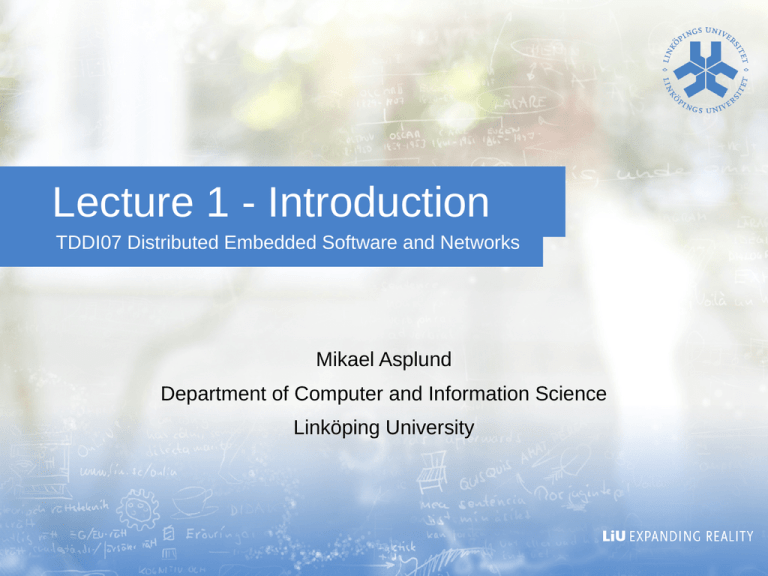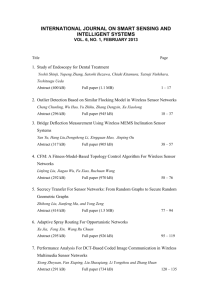Lecture 1 - Introduction Mikael Asplund Department of Computer and Information Science
advertisement

Lecture 1 - Introduction TDDI07 Distributed Embedded Software and Networks Mikael Asplund Department of Computer and Information Science Linköping University Next generation networks [Photo: Cybelter] [Photo: Obra19] [Photo: Patrick B] Course information ● Website: http://www.ida.liu.se/~TDDI07 ● ● Lecturers ● ● Mikael Asplund (mikael.asplund@liu.se) Course assistant ● ● Lectures, labs, etc Ekhiotz Vergara (ekhiotz.vergara@liu.se) Course secretary ● Carita Lilja (carita.lilja@liu.se) Course aims This course will introduce fundamental concepts needed to understand, design, and implement distributed embedded systems that include elements of wireless communication and have some dependability requirements. Three themes ● Energy-efficient network protocols ● Dependability and security ● Clock synchronisation and positioning Course literature ● See course web page! Laboratory ● ● Create two applications using Motes Emulate a distributed sensor network and transfer data from several sources to a sink node ● Uses the TinyOS mote platform ● More details given in Lesson 1 You are required to read the material before each lab. Especially read the first lab before the lesson. Rules of conduct ● Do not cheat ● See web page How to study ● Go to lectures ● Read the literature ● Prepare for labs Seminar ● New for this year ● Optional ● Replaces one part of the exam 10p/40p ● Topic: Dependability and security This lecture ● Introduction to Embedded Distributed Systems ● Wireless sensor networks: ● Applications ● Enabling technologies Embedded systems Distributed systems ● ● ● Di students: recall TDTS04 Multiple autonomous computers connected through a network with a common goal Challenges: Time and clocks, fault tolerance, security, etc Infrastructure-based wireless networks Typical wireless network: Based on infrastructure ● ● E.g. GSM, UMTS, Wifi... Mobility is supported by switching from one base station to another er s Gateways h rt o rk u F w t ne IP backbone Server Router Ad hoc networks ● A network without infrastructure, using networking abilities of the participants Limited range → multi hop networks Infrastructure-free networks ● Factory floor automation ● Disaster area networks ● Car 2 car communication ● Body-area networks Mobility ● In infrastructure-based networks: handover ● In ad-hoc networks: dynamic routing What about scale? Scale constraints ● Single-sink single-hop WSN ● ● Rα T 8D Single-sink multi-hop WSN ● ● N≤ N≤ Rα T 8Dh Multi-sink multi-hop WSN ● N≤ S Rα T 8Dh N −number of nodes R−channel bit rate α −overhead factor (≤1) T −time between samples D−sample size (bytes) h−number of hops S −number of sinks Application examples Remote monitoring Photo: Samuli Lintula Photo: Baytownbert Photo: Petritap Machine surveillance ● Cables cannot go everywhere ● E.g., tire pressure monitoring (required by law in US) Disaster prevention and relief ● ● ● Drop sensor nodes from an aircraft over a wildfire Each node measures temperature Derive a “temperature map” Photo: Lotus R Precision agriculture Bring out fertilizer/irrigation only where needed Car2car communication eCall San-Francisco parking Sports Industry 4.0 Enabling technologies for WSAN ● ● ● Cost reduction Miniaturization “Smart dust” Energy scavenging Vision: intelligent dust 1 mm3 computer Thickfilm battery Solar cell Analog I/O Microcontroller Sensors Optical transmitter Optical receiver RF front-end Two main application categories ● ● Event detection ● Boolean condition ● Position of the event ● Bounded delay Process estimation ● Comparatively more data ● Signal processing (possibly in the network) ● Time synchronization Sensor node architecture Communication device Sensors/ actuators CPU Memory Power supply Sensor node architecture Communication device Sensors/ actuators CPU Memory Power supply Energy density [Thackeray, Wolverton and Isaacs “Electrical energy storage for transportation—approaching the limits of, and going beyond, lithium-ion batteries”, DOI: 10.1039/C2EE21892E, 2012] Energy scavenging – overview Sensor node architecture Communication device Sensors/ actuators CPU Memory Power supply Examples ● Microcontrollers suitable for WSANs ● Texas Instruments MSP430 – ● 16-bit RISC core, up to 4 MHz, versions with 2-10 kbytes RAM, several DACs, RT clock, prices start at 0.49 US$ Atmel ATMega – 8-bit controller, larger memory than MSP430, slower Multiple power consumption modes ● Typical modes ● ● ● Controller: Active, idle, sleep Radio mode: Turn on/off transmitter/receiver, both Multiple modes possible, “deeper” sleep modes ● ● ● Strongly depends on hardware TI MSP 430, e.g.: four different sleep modes Atmel ATMega: six different modes Some energy consumption figures ● Microcontroller ● ● TI MSP 430 (@ 1 MHz, 3V): – Fully operation 1.2 mW – Deepest sleep mode 0.3 W – only woken up by external interrupts (not even timer is running any more) Atmel ATMega – Operational mode: 15 mW active, 6 mW idle – Sleep mode: 75 W Switching between modes ● ● ● ● Simplest idea: Greedily switch to lower mode whenever possible Problem: Time and power consumption required to reach higher modes not negligible ● Introduces overhead ● Switching only pays off if Esaved > Eoverhead Esaved Example: Eoverhead Event-triggered wake up from Pactive sleep mode Scheduling problem Psleep with uncertainty t1 down tevent up time Sensor node architecture Communication device Sensors/ actuators CPU Memory Power supply Flash energy consumption [Lee, Yang, Tseng, IEEE TVLSI 2008] Sensor node architecture Communication device Sensors/ actuators CPU Memory Power supply Transceiver states ● Transceivers can be put into different operational states, typically: ● ● ● ● Transmit Receive Idle Sleep Some transceiver numbers Comparison: GSM Base Station Heat 602W ● Overview AC power 3802W PS 84% DC power TRX 3200W 2400W -48V CE 800W BTS AC Power supply ● Details 220V RF power 480W Central equipm. Combining Heat 800W Total Heat 3682W -48V -48V 300W Common 500W Fans cooling 99% 3232W PAs consume dominant part of power (12*140W)/2400W=70% 3200W 2400W (just to put things into perspective) Usable PA efficiency 40W/140W=28% Overall efficiency (12*10W)/3802W=3.1% (No active cooling) 12 transceivers 200W ● TOC RF 120W ACE TRXs Rack cabling 85% 3802W Heat 360W Heat 1920W idle 140W 60W Converter 85% -48V/+27V 119W Erlang 9W efficiency 75% DTX activity 47% 110W Bias Combiner PA 40W Diplexer TOC 15W 10W Energy cost ● Computation vs. Communication Tradeoff? ● ● Energy ratio of “sending one bit” vs. “computing one instruction”: Anything between 220 and 2900 in the literature To communicate (send & receive) one kilobyte = computing three million instructions! A brief look at channel modelling Attenuation © http://141.84.50.121/iggf/Multimedia/Klimatologie/physik_arbeit.htm 50 2011-02-17 Baspresentation LiU Distortion effects ● Because of reflection, scattering, …, radio communication is not limited to direct line of sight communication ● Effects depend strongly on frequency, thus different behavior at higher frequencies LOS pulses Non-line-of-sight path Line-ofsight path multipath pulses signal at receiver © Jochen Schiller, FU Berlin 51 2011-02-17 Baspresentation LiU Wireless signal strength ● Brighter color = stronger signal © Jochen Schiller, FU Berlin 52 2011-02-17 Baspresentation LiU Allocation... Noise and interference ● ● 54 Noise – due to effects in receiver electronics, depends on temperature ● Typical model: an additive Gaussian variable, mean 0, no correlation in time Interference from third parties ● Co-channel interference ● Adjacent-channel interference 2011-02-17 Baspresentation LiU Wireless channel quality – summary ● ● 55 Wireless channels are substantially worse than wired channels ● In throughput, bit error characteristics, energy consumption, … Wireless channels are extremely diverse ● There is no such thing as THE typical wireless channel ● Various schemes for quality improvement exist ● See book chapter 3! 2011-02-17 Baspresentation LiU Sensor node architecture Communication device Sensors/ actuators CPU Memory Power supply Sensors ● Active / passive ● Narrow-beam / omnidirectional ● Coverage ● Noise and contradictory sensor readings! ● Sensor fusion Programming WSANs ● Extremely simple devices ● Little system support (OS, virtual memory etc) ● Event-based systems ● NesC and TinyOS suitable! More on this in coming lesson. www.liu.se





